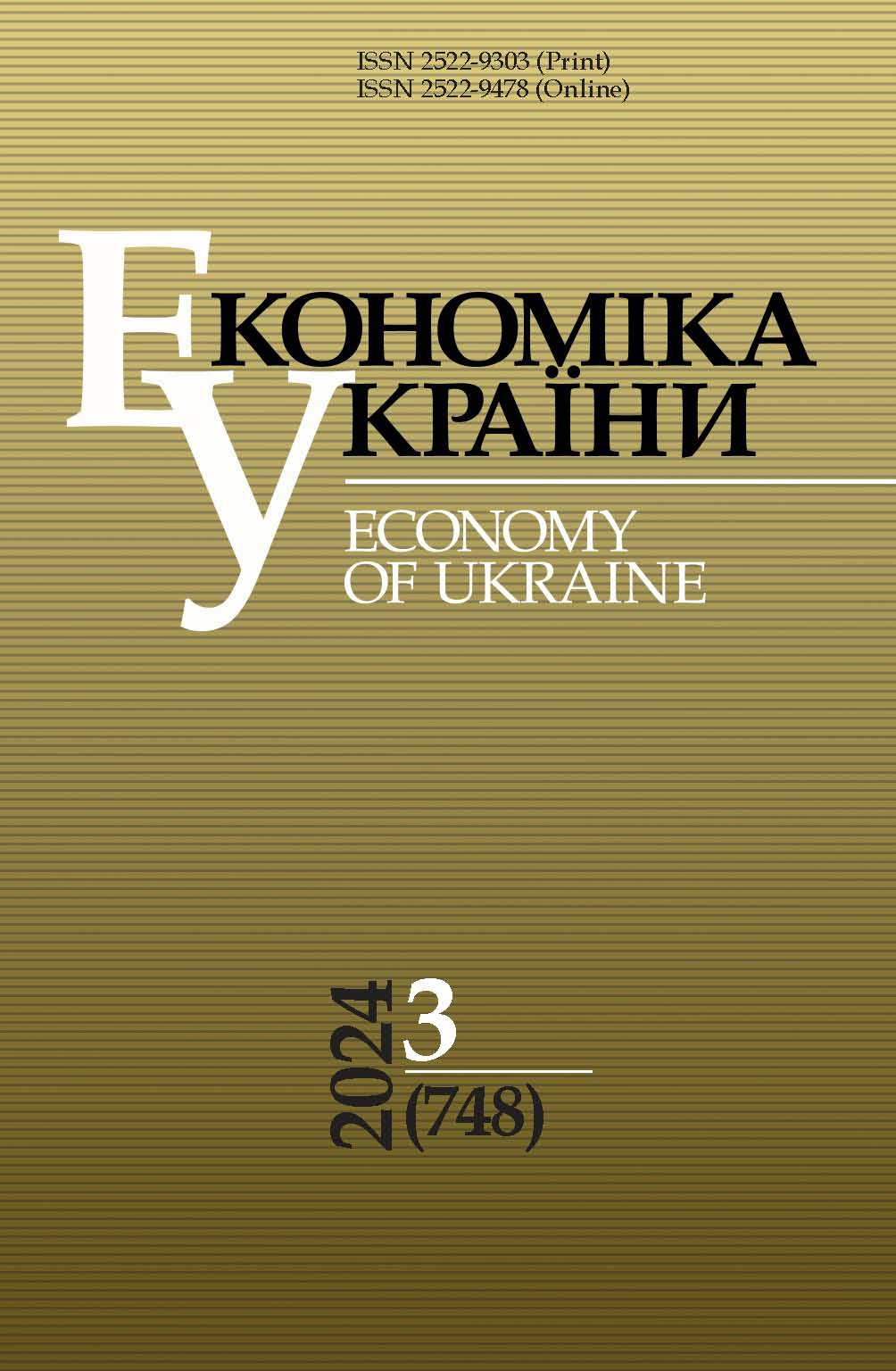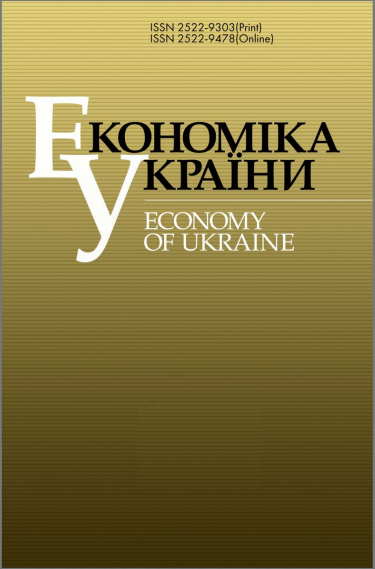STUDYING THE RELATIONSHIP BETWEEN THE PRICE OF GOLD AND THE INFLATION RATE PERSISTENCE IN ALGERIA USING THE FRACTIONAL INTEGRATION MODEL
DOI:
https://doi.org/10.15407/economyukr.2024.03.072Keywords:
inflation rate persistence; gold price shocks; fractional cointegration; AlgeriaAbstract
This study aims to analyse the relationship between gold price and inflation rates in Algeria to determine the extent of inflation persistence in face to gold price shocks from January1992 to March 2023 using the recently developed Fractional Cointegration Model, which allows residuals to be fractionally integrated rather than stationary, with the classical cointegration approach based on I(0) stationarity or I(1) cointegrating relationships. This topic was chosen due to its significance for monetary policymakers, investors, financial analysts and academics in understanding the dynamics of inflation persistence in Algeria and studying the impact of some prices shocks on it, such as gold price shocks, These shocks were affected by several factors, the most important of which is the Ukrainian war, which contributed to the rise of gold price to record levels. Our results also showed that Algeria has a co-integration relationship between gold price and the inflation rate, with an estimated persistence of 0.593, which is greater than 0.5 and less than 1. This indicates that the impact of gold price shocks is still present for a long time on the inflation rate persistence in Algeria, in other words the inflation rate in Algeria will persistence for a longer period due to the shock of gold price before eventually fading away, and with the adoption of a monetary policy targeting inflation in Algeria, it will contribute to reducing the inflation rates persistence.
References
Tule, M., Salisu, A., Ebuh, G. (2020). A test for inflation persistence in Nigeria using fractional integration & fractional cointegration techniques. Econ. Model, Vol. 87, pp. 225-237. https://doi.org/10.1016/j.econmod.2019.07.024
Amano, R. (2007). Inflation persistence and monetary policy: A simple result. Econ. Lett, Vol. 94, Iss. 1, pp. 26-31. https://doi.org/10.1016/j.econlet.2006.06.022
Coenen, G. (2007). Inflation persistence and robust monetary policy design. J. Econ. Dyn. Control, Vol. 31, Iss. 1, pp. 111-140. https://doi.org/10.1016/j.jedc.2005.09.012
Tetlow, R. (2019). The monetary policy response to uncertain inflation persistence. Econ.Lett., Vol. 175, pp. 5-8. https://doi.org/10.1016/j.econlet.2018.10.034
Sbordone, A. (2007). Inflation persistence: Alternative interpretations and policy implications. J. Monet. Econ., Vol. 54, Iss. 5, pp. 1311-1339. https://doi.org/10.1016/j.jmoneco.2007.06.007
Bratsiotis, G., Madsen, J., Martin, C. (2015). Inflation Targeting and Inflation Persistence. Econ. Polit. Stud., Vol. 3, Iss. 1, pp. 3-17. https://doi.org/10.1080/20954816.2015.11673835
Gerlach, S., Tillmann, P. (2012). Inflation targeting and inflation persistence in Asia–Pacific. J. Asian Econ., Vol. 23, Iss. 4, pp. 360-373. https://doi.org/10.1016/j.asieco.2012.03.002
Meller, B., Nautz, D. (2012). Inflation persistence in the Euro area before and after the European Monetary Union. Econ. Model., Vol. 29, Iss. 4, pp. 1170-1176. https://doi.org/10.1016/j.econmod.2012.03.016
Misati, R., Nyamongo, E., Mwangi, I. (2013). Commodity price shocks and inflation in a net oil-importing economy. OPEC Energy Rev., Vol. 37. pp. 125-148. https://doi.org/10.1111/opec.12010
Aye G., Carcel H., Gil-Alana L., Gupta R. (2017). Does gold act as a hedge against inflation in the UK? Evidence from a fractional cointegration approach over 1257 to 2016. Resour. Policy, Vol. 54, pp. 53–57. https://doi.org/10.1016/j.resourpol.2017.09.001
Lucey, B., Sharma, S., Vigne, S. (2017). Gold and inflation(s) – A time-varying relationship. Econ. Model., Vol. 67, pp. 88-101. https://doi.org/10.1016/j.econmod.2016.10.008
Salisu, A., Ndako, U., Oloko, T. (2019). Assessing the inflation hedging of gold and palladium in OECD countries. Resour. Policy, Vol. 62, pp. 357–377. https://doi.org/10.1016/j.resourpol.2019.05.001
Antonakakis, N., Cunado, J., Gil-Alana, L., Gupta, R. (2016). Is inflation persistence different in reality? Econ. Lett., Vol. 148, pp. 55-58. https://doi.org/10.1016/j.econlet.2016.09.003
Johansen, Sø. (2008). A representation theory for a class of vector autoregressive models for fractional processes. Econom. Theory, Vol. 24, No. 3, pp. 651-676. https://doi.org/10.1017/S0266466608080274
Johansen, S., Nielsen, M. (2012). Likelihood Inference for a Fractionally Cointegrated Vector Autoregressive Model. Econometrica, Vol. 80, No. 6, pp. 2667-2732. https://doi.org/10.3982/ECTA9299
Johansen, S. (1995). Likelihood-Based Inference in Cointegrated Vector Autoregressive Models. 1st ed. Oxford, Oxford University Press. https://doi.org/10.1093/0198774508.001.0001
Gil-Alana, L., Yaya, O., Awe, O. (2017). Time series analysis of co-movements in the prices of gold and oil: Fractional cointegration approach. Resour. Policy, Vol. 53, pp. 117-124. https://doi.org/10.1016/j.resourpol.2017.06.006
Gil-Alana, L., Carcel, H. (2020). A fractional cointegration var analysis of exchange rate dynamics. North Am. J. Econ. Finance, Vol. 51, p. 100848. https://doi.org/10.1016/j.najef.2018.09.006
Granville, B., Zeng, N. (2019). Time variation in inflation persistence: New evidence from modelling US inflation. Econ. Model., Vol. 81, pp. 30-39. https://doi.org/10.1016/j.econmod.2018.12.004
Bilici, B., Çekin, S. (2020). Inflation persistence in Turkey: A TVP-estimation approach. Q. Rev. Econ. Finance, Vol. 78, pp. 64-69. https://doi.org/10.1016/j.qref.2020.04.002
Batini, N., Nelson, E. (2001). The Lag from Monetary Policy Actions to Inflation: Friedman Revisited. Int. Finance, Vol. 4, No. 3, pp. 381-400. https://doi.org/10.1111/1468-2362.00079
Roache, S. (2014). Inflation Persistence in Brazil: A Cross Country Comparison. IMF Working Paper, No. 14/55. 23 p. https://doi.org/10.5089/9781475585230.001
Fuhrer, J., Moore, G. (1995). Inflation Persistence. Q. J. Econ., Vol. 110, No. 1, pp. 127-159. https://doi.org/10.2307/2118513
Stock, J. Watson, M. (2003). Forecasting Output and Inflation: The Role of Asset Prices. J. Econ. Lit., Vol. 41, No. 3, pp. 788-829. https://doi.org/10.1257/002205103322436197
Wang, G. (2019). Marx’s monetary theory and its practical value. China Polit. Econ., Vol. 2, No. 2, pp. 182-200. https://doi.org/10.1108/CPE-10-2019-0026
Mishkin, F. (1990). What does the term structure tell us about future inflation? J. Monet. Econ., Vol. 25, No. 1, pp. 77-95. https://doi.org/ 10.1016/0304-3932(90)90046-7
Kent, C., Lowe, P. (1997). Monetary Policy and Bubbles: A Simple Model| RDP 9709: Asset-Price Bubbles and Monetary Policy. Reserve Bank Aust. Res. Discuss. Pap., no. December, 1997. URL: https://www.rba.gov.au/publications/rdp/1997/pdf/rdp9709.pdf
Fama, E., Schwert, G. (1977). Asset returns and inflation. J. Financ. Econ., Vol. 5, No. 2, pp. 115-146. https://doi.org/10.1016/0304-405X(77)90014-9
Dalziel, P. (1999). A Post Keynesian theory of asset price inflation with endogenous money. J. Post Keynes. Econ., Vol. 22, No. 2, pp. 227-245. https://doi.org/10.1080/01603477.1999.11490238
Fei, F. (2009). Theories of Gold Price Movements: Common Wisdom or Myths? Pension Incentives and Premature Retirement’, PhD Thesis. URL: https://deepblue.lib.umich.edu/bitstream/handle/2027.42/63919/fei_fan_2009.pdf?sequence=1
Laurent, R. D. (1994). Is there a role for gold in monetary policy. Economic Perspectives, 18(2), 2–14. URL: https://www.chicagofed.org/publications/economic-perspectives/1994/03marapr1994-part1-laurent
Garner, C. (1995). How useful are leading indicators of inflation? Fed. Reserve Bank Kans. City Econ. Rev., Vol. 80, No. 2, pp. 5-18. URL: https://citeseerx.ist.psu.edu/document?repid=rep1&type=pdf&doi=77879fc25e394ef1f76fa040b8c6e8c8c4568315
Bernanke, B., Gertler, M., Watson, M., Sims, C., Friedman, B. (1997). Systematic Monetary Policy and the Effects of Oil Price Shocks. Brook. Pap. Econ. Act., Vol. 1997, No. 1, pp. 91-157. https://doi.org/10.2307/2534702
Oloko, T., Ogbonna, A., Adedeji, A., Lakhani, N. (2021). Fractional cointegration between gold price and inflation rate: Implication for inflation rate persistence. Resour. Policy, Vol. 74, 102369. https://doi.org/10.1016/j.resourpol.2021.102369
Oloko, T., Ogbonna, A., Adedeji, A., Lakhani, N. (2021). Oil price shocks and inflation rate persistence: A Fractional Cointegration VAR approach. Econ. Anal. Policy, Vol. 70, pp. 259-275. https://doi.org/10.1016/j.eap.2021.02.014
Geronikolaou, G., Spyromitros, E., Tsintzos, P. (2020). Progressive taxation and human capital as determinants of inflation persistence. Econ. Model., Vol. 88, pp. 82-97. https://doi.org/10.1016/j.econmod.2019.09.011
Wu, J.-W., Wu, J.-L. (2018). Does a flexible exchange rate regime increase inflation persistence? J. Int. Money Finance, Vol. 86, pp. 244-263. https://doi.org/10.1016/j.jimonfin.2018.05.002
Canarella, G., Miller, S. (2016). Inflation persistence and structural breaks. J. Econ. Stud., Vol. 43, No. 6, pp. 980-1005. https://doi.org/10.1108/JES-10-2015-0190
Batten, J., Ciner, C., Lucey, B. (2014). On the economic determinants of the gold-inflation relation. Resour. Policy, Vol. 41, pp. 101-108. https://doi.org/10.1016/j.resourpol.2014.03.007.
Mishkin, F., Schmidt-Hebbel, K. (2007). Does Inflation Targeting Make a Difference? NBER Working Paper, No. w12876. URL: https://ssrn.com/abstract=961141
Solarin Sakiru Adebola, Gil-Alana L., Madigu, G. (2019). Gold prices and the cryptocurrencies: Evidence of convergence and cointegration. Phys. Stat. Mech. Its Appl., Vol. 523, pp. 1227-1236. https://doi.org/10.1016/j.physa.2019.04.123
Yaya, O., Ogbonna, A., Atoi, N. (2019). Are inflation rates in OECD countries actually stationary during 2011-2018? Evidence based on Fourier Nonlinear Unit root tests with Break. University Library of Munich, Germany. MPRA Paper, No. 93937. https://econpapers.repec.org/paper/pramprapa/93937.htm
Granger, C. (1981). Some properties of time series data and their use in econometric model specification. J. Econom., Vol. 16, No. 1, pp. 121-130. https://doi.org/10.1016/0304-4076(81)90079-8
Granger, C. (1980). Long memory relationships and the aggregation of dynamic models. J. Econom., Vol. 14, No. 2, pp. 227-238. https://doi.org/10.1016/0304-4076(80)90092-5
Granger, C., Joyeux, R. (1980). An introduction to long‐memory time series models and fractional differencing. J. Time Ser. Anal., Vol. 1, No. 1, pp. 15-29. https://doi.org/10.1111/j.1467-9892.1980.tb00297.x
Hosking, J. (1981). Fractional Differencing. Biometrika, Vol. 68, No. 1, pp. 165-176. https://doi.org/10.2307/2335817
Adenstedt, R. (1974). On large-sample estimation for the mean of a stationary random sequence. Ann. Stat., Vol. 2, No. 6, pp. 1095–1107. https://doi.org/10.1214/aos/1176342867
Gil-Alana, L., Carcel-Villanova, H. (2018). A fractional cointegration var analysis of exchange rate dynamics. North Am. J. Econ. Finance, Vol. 51. https://doi.org/10.1016/j.najef.2018.09.006
Engle, R., Granger, C. (1987). Co-Integration and Error Correction: Representation, Estimation, and Testing. Econometrica, Vol. 55, No. 2, pp. 251-276. https://doi.org/10.2307/1913236
Robinson, P. (2008). Multiple local whittle estimation in stationary systems. Ann. Stat., Vol. 36, No. 5, pp. 2508-2530. https://doi.org/10.1214/07-AOS545
MacKinnon, J., Nielsen, M. (2014). Numerical distribution function of fractional unit root and cointegration tests: fractional cointegration tests. J. Appl. Econom., Vol. 29, No. 1, pp. 161-171. https://doi.org/10.1002/jae.2295
Downloads
Published
How to Cite
Issue
Section
License
Copyright (c) 2024 Publisher PH "Academperiodyka" of the NAS of Ukraine

This work is licensed under a Creative Commons Attribution-NonCommercial-NoDerivatives 4.0 International License.



